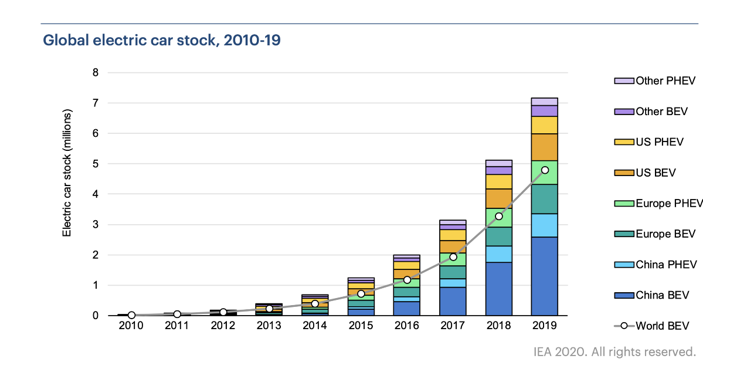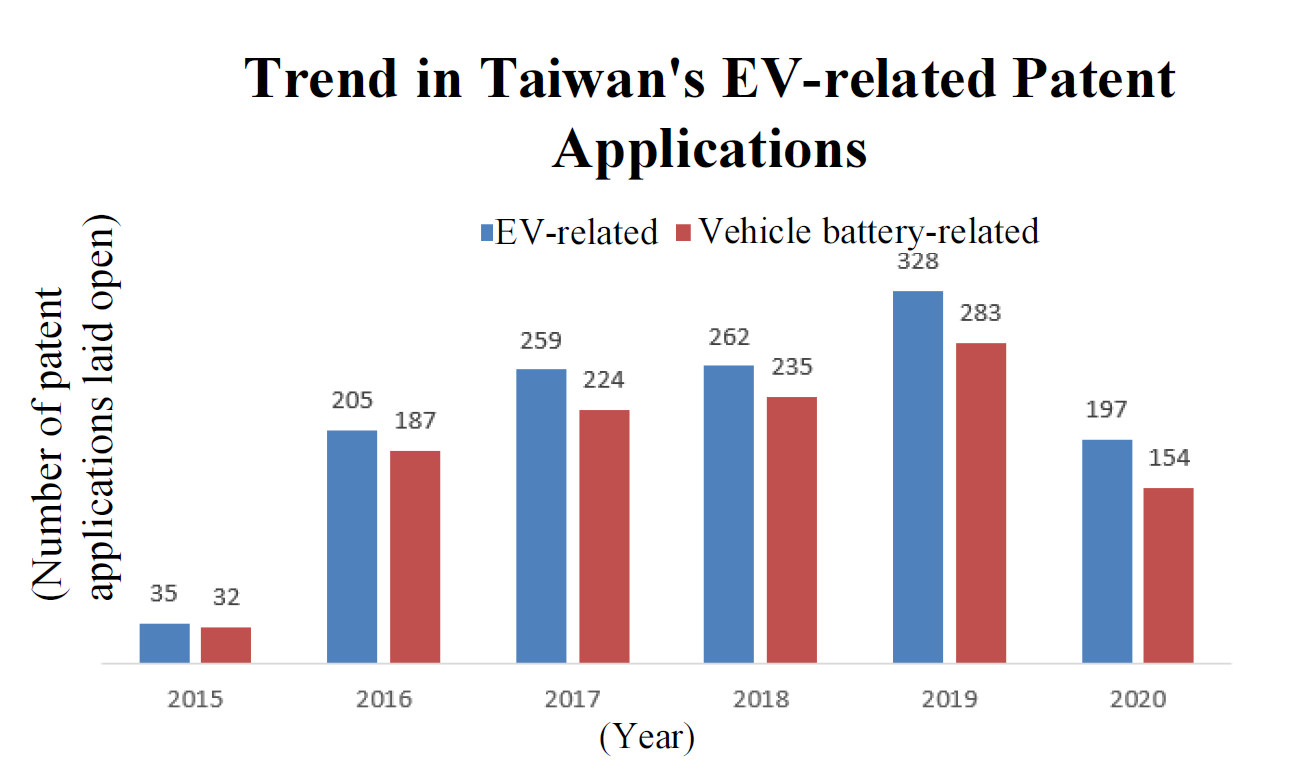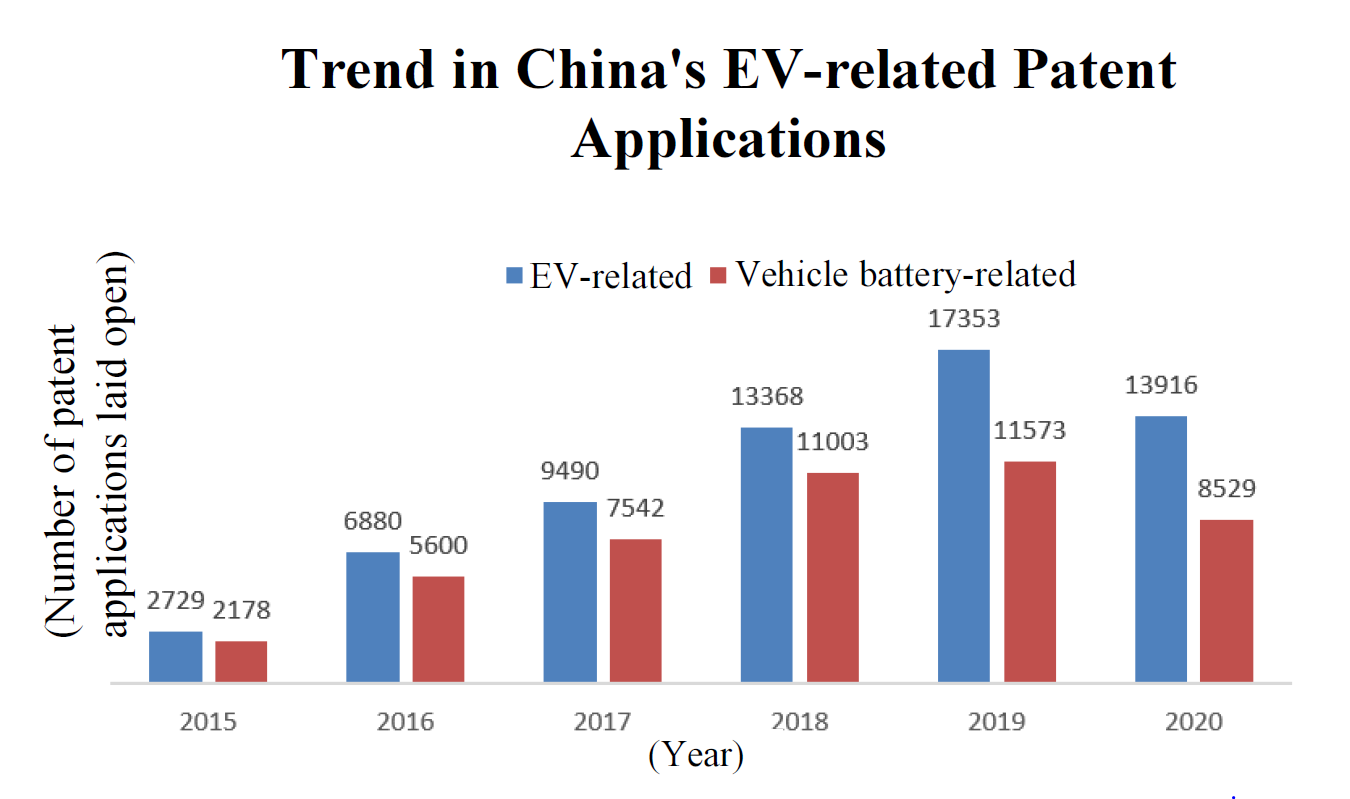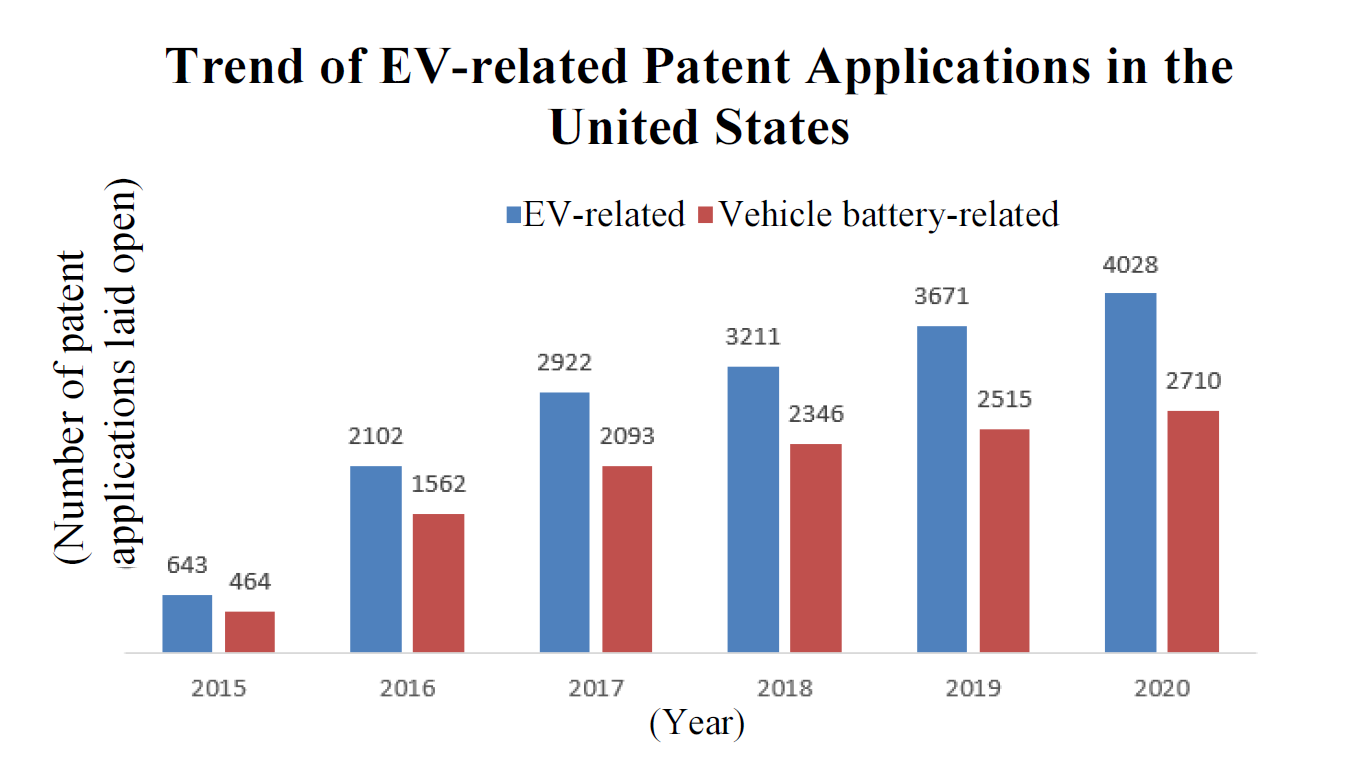Newsletter
On Patent Application Strategy and Patent Portfolio: Trends in Electric Vehicles and Their Patent Applications
The number of electric vehicles (EVs) is growing in response to the environmental policies of various countries, and the technological development of EVs has enabled not only vehicle-related enterprises but also more relevant enterprises to enter the EV industry, thus changing the landscape of the vehicle industry. With respect to the trends of patent applications in Taiwan, the United States and China, the number of patents related to EVs is increasing each year, and the number of patent applications for vehicle batteries and charging technology accounts for the majority of cases. To cope with the current development trends of EVs and patent application, enterprises may arrange their own corresponding patent strategies at various R&D stages in order to effectively protect their R&D results and avoid infringing the patent rights of other enterprises.
1. Environmental Protection Policies and Growth of EVs in Various Countries
As environmental awareness prevails nowadays, and the requirements for emission standards become more and more stringent, many countries have unveiled their goals of achieving zero greenhouse gas emissions by 2050 based on the Paris Agreement1. To cite certain instances, Germany and India vow to completely ban the sale of fossil fuel vehicles in 2030; the United Kingdom proposed "Green Industrial Revolution" plan2 on November 18, 2020, announcing that the original schedule to phase out new fossil fuel vehicles in 2040 will be moved forward to 2030 while the sale of new hybrid vehicles will still be allowed until 2035; in December 2020, the Japanese government also started the preparation and plan3 to phase out the sale of fossil fuel vehicles by the mid-2030s; Norway and the Netherlands even pledge to completely ban fossil fuel vehicles by 2025; other EU countries also set up regulations to imposes strict carbon reduction obligations on vehicle manufacturers. With the foregoing examples, we can see the determination and green policies of major countries to achieve the goal of zero greenhouse gas emissions by 2050.
Under such an atmosphere and policy, major global vehicle manufacturers, such as Ford and Honda, have successively announced to gradually phase out their fossil fuel vehicles in the decade to come. In September 2020, Taiwan's Industrial Technology Research Institute (ITRI) and more than 50 enterprises jointly established the "Taiwan Electric Vehicle Recharging Industry Technology Promotion Consortium"4 to integrate EV industry affiliates, formulate a common charging interface, and build Taiwan's EV industry ecosystem with a common charging transmission and communication standard in order to provide users with a more convenient charging environment and to facilitate the penetration rate of EVs and the development of related industries in Taiwan.
With the unanimous consensus across the globe to prevent global warming, a common direction for all vehicle manufacturers lies in the research and development on performance enhancement of electric vehicles, hybrid electric vehicle (HEV) or the like. According to the Global EV Outlook 20205, a survey conducted by the International Energy Agency (IEA), the number of EVs in use worldwide grew by about 60% per year from 2014 to 2019, reaching about 7.2 million units in 2019. China's aggressive incentives and policies for the EV industry have prompted automakers to accelerate the development of EVs to meet the needs of the general public, surpassing the United States as the world's largest EV market in 2017 and accounting for about 47% of the world's EVs in 2019.

2. Development of EVs
Although EVs had its debut as early as 1834, the early models were subject to factors such as technical constraints in battery capacity, charging speed, and the distance traveled on a single charge. It is not until recent years that the development of EVs has become more mature and rapid due to technical breakthroughs.
In terms of the R&D of battery electric vehicle (BEV) and hybrid vehicle (HV), Tesla and Toyota are the leaders in these two fields. For a long time, they have invested resources in the R&D of batteries, motors, power distribution devices or power control units. However, both BEVs and HVs require more newcomers so as to set up more essential infrastructures like charging stations, avoid technologies with competitive edge from being isolated, and facilitate more favorable government policies. Consequently, though having a large number of patents as a forerunner of the field, Toyota granted royalty-free licenses6 of its EV and fuel cell related technology patents, 23,740 in total, in April 2019, in the hope to promote the use of HV. Not actively applying for patents, Tesla also granted royalty-free licenses on more than 200 patents related to EVs in 2014. By doing so, both Toyota and Tesla look forward to not only the adoption of their own technologies as the industry standards, but also interests and investments from more vehicle manufacturers to this field, thereby facilitating the development of EVs
The rapid increase of Tesla's EV sales in recent years has also prompted major vehicle manufacturers to actively pursue their electrification strategies. Porsche, one of the luxury vehicle brands, aims to achieve half of its total sales as HVs or BEVs by 20257. “Taycan,” Porsche’s first mass-produced EV launched in 2020, has a range of 500km on a charge and can be charged quickly, with an endurance of 100km on a five-minute charge, saving a lot of time at charging stations. In addition, veteran vehicle manufacturers, such as Audi, Mercedes-Benz and BMW have also launched their mass-produced EV products, helping EVs reach even further.
As mentioned above, the policies and enterprise trends of various countries all show that EVs have become a revolution that the vehicle industry must face. Ten to thirty years from now, fossil fuel vehicles and even HEVs will be withdrawn from the market one after another. Allied Market Research estimates that the global EV industry will reach US $567.2 billion (about NT $17 trillion) in 20258. While the vehicle related industry, needless to say, has to live up to this historic opportunity, other related enterprises should also speed up to meet the changes of the times and seek the possibility to maximize their benefit by bridging their own technology with the field of EV. Enterprises of EV related technologies—such as communication or video technologies, transmission components, electrical equipment, control chips or systems, and electronic control-related technologies—are bound to catch up with this EV trend and meet new business opportunities by establishing partnerships with major vehicle manufacturers. Enterprises can find their own advantages if they incorporate their own expertise and experiences with the applications in EV related technologies.
3. EVs Will Change the Landscape of the Vehicle Industry
Compared with the parts of fossil fuel vehicles, EVs requires 30% less in number since the parts related to the vintage internal combustion engine such as engines, transmissions and other powertrain components and intake and exhaust system components are replaced by battery and motor-related components in EVs. The high technical expertise to produce these power system parts developed over the years by the century-old vehicle manufacturers is not required, which, in other words, means lower entry threshold for the EV industry, significantly increasing the possibility of entering the EV sector for enterprises that manufacture batteries or motors. For instance, BYD Auto, a Chinese vehicle manufacturer established in 2003 byChina's major battery maker BYD, has developed and produced a number of EV models within several years and rapidly expand its market share since. Now BYD Auto has become the largest EV manufacturer in China. Meanwhile, the founder of Tesla was not a vehicle manufacturer before, either, and Apple is surely not be absent to this trend and will launch its first EV, the “Apple Car.”
To take Dyson as another example, as Dyson is experienced in motor and battery related technologies, it has developed its own SUV EV equipped with its self-developed electric motor that can travel up to 960km on a single charge. Although this EV development project was ceased in October 2019 due to commercial cost considerations, the solid-state battery technology and next-generation motor technology developed during the EV development process are important EV-related technologies and can still play a key role when Dyson cooperates with other other EV manufacturers in the future. In addition, Amazon also invested in Rivian, an electric truck company, to launch a customized battery electric truck, which serves as the last mile of Amazon's logistics to fulfill its Climate Pledge.
CATL, which has also entered the Tesla supply chain along with PANASONIC, is actively developing battery technologies without cobalt or even nickel so as to reduce battery production costs and increase the endurance of EVs. CATL also claims that the new battery currently developed for Tesla will have a total range of 2 million kilometers. At present, the major global battery manufacturers are CATL, LG Chem, PANASONIC and BYD, and these manufacturers account for nearly 80% of the major global EV battery market.9
In Taiwan, Fortune Electric, a Taiwan-based power equipment manufacturer, has developed the EValue electric vehicle charging station in recent years, combining solar power and energy storage. They have been building charging equipment for Tesla and Porsche since 2016. In addition, Hota Industrial, after having invested with higher cost and established a transmission shaft supply chain for EVs ahead of time, successfully catches up with the EV trend and becomes a supplier of Tesla even though its scale is still smaller than that of fossil fuel vehicles. Moreover, the rise of the EV industry also revitalizes the relevant parts and material industries concerning power modules, motors, reduction gears, copper foils and the like..
While major vehicle manufacturers would develop common modular platforms for their various vehicle models in the past, this platform concept can also be applied to EVs as well and further facilitate R&D and production cost reduction and product diversification for new entrants. For example, a battery module can be installed in the chassis of a vehicle together with a wheel hub motor module system. This model can serve as a modularized platform and be applied to different commercial EVs.
To fully utilize the advantage of platform, Foxconn and Yulon Motor have collaborated on an “MIH EV Open Platform” since 2020 to provide non-traditional automobile enterprises with easy access to the pipeline of EV production without spending huge cost and long lead time for the development of vehicle chassis and battery. On the basis of its modular and customizable design and scalable capability, this platform will allow enterprises to focus on the exteriors and interiors of their new branded models, and adjust their drive systems, wheelbase, and other hardware architectures to meet individual needs. Even those electronics technology enterprises previously not involved in vehicle development and manufacturing may be able to participate in EV if they join this platform.
4. Current Trends in EV-related Patent Applications
As seen from the figure below, the number of invention patent applications filed and laid open in Taiwan since 2015 (indicated as the blue bars) is increasing year by year according to the statistics shown in B60L1, B60L3, B60L7, B60L9, B60L15, B60L50, B60L53, B60K6/20, B60W20, B60R16, H01M and H02J-7, which are IPC codes associated with EV-related technologies. Further analysis shows that the IPC codes, H01M and H02J-7, related to vehicle battery, account for the vast majority of the patent applications (indicated as the red bars), suggesting that the current R&D trend mainly concentrates on the fields of vehicle battery and charging technology.

(Source: Taiwan Patent Search System; https://twpat.tipo.gov.tw/; search date: November 17, 2020)
Similarly, it can be seen that the number of invention patent applications filed and laid open in China since 2015 (indicated as the blue bars) is also increasing trend year by year. Both IPC codes H01M and H02J-7, which are related to vehicle battery, account for the vast majority of the patent applications (indicated as the red bars).

(Source: China and Global Patent Examination Information Inquiry, http://cpquery.cnipa.gov.cn/, searched on November 17, 2020)
As for the case in the United States, the trend is similar upon the analysis of the invention patent applications.

(Source: Patent Full-Text Databases; http://patft.uspto.gov/; search date: November 17, 2020)
As the above EV-related patent application trends show, solid-state batteries with high safety and high performance will be the mainstream for the batteries equipped in EVs in the future so as to provide users with EVs that have longer endurance and shorter charging time. Although it is estimated that EV power-related patents will still account for a large proportion in the future, we recommend that more attention can also be paid for the patents concerning cloud upload of information or data related to EV’s behaviors or battery management for further optimization in EV control and battery management.
5. Patent Application Strategy and Patent Portfolio
As technology moves ahead every day, the world has entered a new era of AI explosion since 2019, and the use of AI and deep learning technology for R&D accelerates the lead time for technological innovation. In such circumstances, in order to avoid possible infringement of other parties' patent rights or changing the R&D direction halfway, it is important to regularly review and analyze patents that are granted and published and patent applications that are laid open before enterprises invest time and cost in R&D. Upon the completion of R&D, it is recommended to obtain appropriate patent protection of new technologies. After all, copyright protection not only enables enterprises to take countermeasures when the R&D results are copied by competitors, but also offers the grounds for enterprises to cross-license with related enterprises so as to reduce the license fee or exchange other preferential terms. Even if the patent obtained is not actually applied to the product, enterprises may consider to license the patent to other enterprises so as to receive royalties.
The overall planning and implementation of management strategies and specific objectives of enterprise intellectual property rights should be done by the intellectual property or legal personnel under the instruction of the senior management team. Enterprises may also consider commissioning the patent or law firms to assist in the implementation. Nowadays, major vehicle manufacturers and new entrants all actively aim for the competitive edge in R&D, and obtain the patent rights of their new technology as soon as possible in order to protect their commercial interests in the future EV market. Therefore, flexibility and promptness is a must in acquiring the relevant patents with competing enterprises. It is recommended to set up a special team to be in charge of this matter or to fully utilize the professional personnel and expertise of experienced patent or legal firms lest the patent rights of other enterprises should be infringed by accident.
As a result, before enterprises invest in research and development, first they must conduct patent searches in the target technical field in order to confirm the scope of other enterprises’ R&D results. In that case, they can avoid wasting time and cost on conducting similar R&D results and prevent from infringing the patent rights of other enterprises by designing around as appropriate.
If the enterprises do not find any R&D results and patents associated with other enterprises that are published or laid open until when they have already conducted their own R&D project, they should analyze the patented technologies and determine whether its own R&D result may infringe the patents in question. They may even consider possibility to invalidate the patents in question or to narrow down the scope of claim(s).
6. Summary
With the dates clearly specified in various countries with regard to EV policies and the active involvement of vehicle manufacturers, we are getting closer to a life in which EVs play a prominent role. The main barriers to EVs' popularity—such as endurance, charging time, charging stations and prices—will gradually be resolved, and EVs will be seen running everywhere by then. With the development of various smart devices and 5G, EV will be more than just a tool for transportation. Now is the critical time for the development of EV.
We encourage EV-related enterprises and even enterprises in different technical fields to pay more attention to the current trends in patent applications and the news updates from various enterprises in EV and battery-related field. It is imperative for enterprises, on the basis their own niches, to pursue technical enhancement and competitive edge and meanwhile protect the R&D results with the rights offered by patents or trade secrets so as to expand market advantages and enterprise values.

